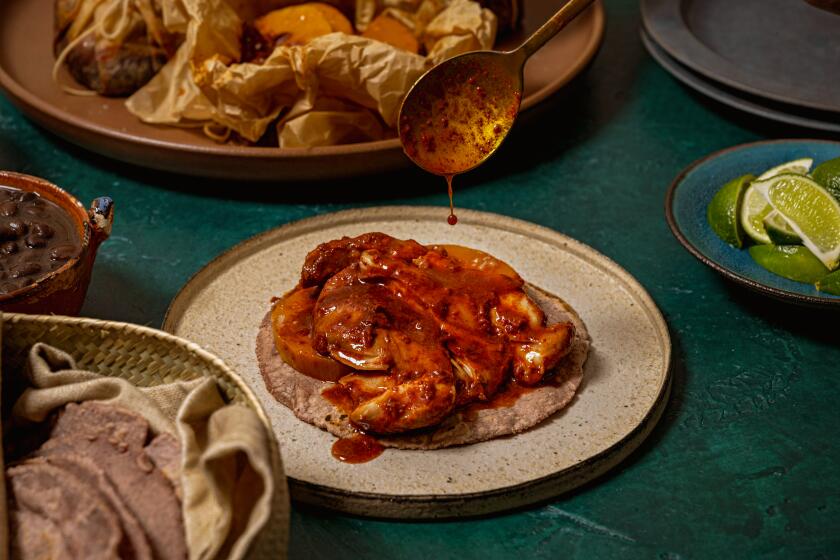Sumaqqiyeh (oxtail stew with chard, sumac and tahini)

- Share via
The green chile, the dill seeds, the tahini sauce — the roll call of typical Gazan ingredients makes this a classic Gazan dish. In Gaza, the tahini would be red tahini, which is nuttier and richer than regular tahini. The difference between the two is the sort of heat the sesame seeds are roasted with; steam heating in the case of regular tahini, roasting with direct heat in the case of red tahini. Just make sure you are starting with what we call “proper tahini,” though any regular creamy Arabic tahini is just fine.
From the story: Palestinian cookbooks help preserve a culture’s identity
Make the tahini sauce: Whisk the tahini, water, lemon juice and salt in a bowl until smooth. Set aside.
To make the stew, put the onions, garlic and two-thirds of the chiles into a food processor. Pulse a few times, until finely minced but not so much that it turns to a puree. Set aside until ready to use.
Put the sunflower oil into a large heavy-bottomed saucepan with a lid and place over medium-high heat. Pat the oxtail dry and sprinkle with ½ teaspoon salt and a good grind of black pepper. In two batches, sear the oxtail for 5 to 6 minutes, turning so that all sides get nicely browned. Once all the meat is browned, transfer to a separate plate, pour off the excess oil and wipe the pan clean. Add the olive oil and the onion, garlic and chile mix and cook for about 4 minutes, stirring often, or until softened. Add the tomatoes and tomato paste and cook for another 4 minutes, or until the tomatoes have broken down. Stir in the cumin, cinnamon and baharat, then add the oxtail, sugar, water, 2¼ teaspoons salt and a generous grind of black pepper. Bring to a boil, then decrease the heat to medium-low, cover the pan and let simmer gently, stirring every so often, for 4 hours or until the meat is tender and almost falling off the bone.
After about 4 hours, use a pair of tongs to remove the oxtail from the pan. Set it aside to cool slightly and add the chickpeas and chard stalks to the pan. Increase the heat to medium-high and cook for 20 to 25 minutes, stirring often, until the sauce has thickened and reduced by half.
Meanwhile, once the oxtail is cool enough to handle, tear off the meat and fat in large chunks, discarding the bones; you should be left with about 1 pound 7 ounces. Return to the pan, along with the chard leaves, dill seeds, parsley, 1½ tablespoons sumac and all but a handful of chopped dill. Cook for about 5 minutes, or until the leaves have wilted and the meat has heated through.
Transfer the stew to a large serving platter and drizzle with a third of the tahini sauce. The remaining sauce can be served in a bowl alongside. Top with the remaining chopped dill, chiles and 1½ teaspoons sumac and serve at once.
Get our Cooking newsletter
Get a taste of Los Angeles — and the world — with recipes and kitchen tricks from the L.A. Times’ Cooking newsletter.
You may occasionally receive promotional content from the Los Angeles Times.















